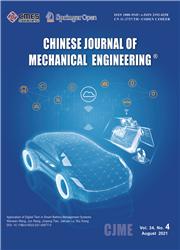Ti-6Al-4V激光辅助磨削的热-机械效应及去除机理
IF 4.5
2区 工程技术
Q1 Engineering
引用次数: 0
摘要
摘要钛合金的低密度和高耐腐蚀性使其在航空航天工业中具有多种用途。但由于其比强度高,导热性差,在常规加工中存在切削力大、表面完整性差、切削温度高等问题。激光辅助加工作为一种高效率、低损伤的先进加工方法,可以提高钛合金的可加工性。在这项研究中,首次提出了一种皮秒脉冲激光辅助刻划(PPLAS)方法,同时考虑了材料的温度依赖特性和超短脉冲激光的特性。然后,通过仿真研究了激光功率、刻划深度和刻划速度对应力场和温度场分布的影响。接下来,通过PPLAS实验验证了仿真的正确性,揭示了不同激光功率和刻划深度组合下的去除行为。最后,结合仿真和实验结果,说明了两种加工方法下的去除机理。与常规刮擦(CS)相比,PPLAS过程中切向磨削力降低60%以上,材料去除度高达0.948,但材料去除仍以塑料去除为主。CS中的磨屑以“鱼鳞”表面堆积的薄片的形式出现,而ppla中的磨屑则以破碎的锯齿的形式出现。该研究为实现高表面质量、低表面损伤的钛合金磨削提供了重要的指导。本文章由计算机程序翻译,如有差异,请以英文原文为准。
Thermal-Mechanical Effect and Removal Mechanism of Ti-6Al-4V During Laser-Assisted Grinding
Abstract The low density and high corrosion resistance of titanium alloy make it a material with various applications in the aerospace industry. However, because of its high specific strength and poor thermal conductivity, there are problems such as high cutting force, poor surface integrity, and high cutting temperature during conventional machining. As an advanced processing method with high efficiency and low damage, laser-assisted machining can improve the machinability of titanium alloy. In this study, a picosecond pulse laser-assisted scratching (PPLAS) method considering both the temperature-dependent material properties and ultrashort pulse laser’s characteristics is first proposed. Then, the effects of laser power, scratching depth, and scratching speed on the distribution of stress and temperature field are investigated by simulation. Next, PPLAS experiments are conducted to verify the correctness of the simulation and reveal the removal behavior at various combinations of laser power and scratching depths. Finally, combined with simulated and experimental results, the removal mechanism under the two machining methods is illustrated. Compared with conventional scratching (CS), the tangential grinding force is reduced by more than 60% and the material removal degree is up to 0.948 during PPLAS, while the material removal is still primarily in the form of plastic removal. Grinding debris in CS takes the form of stacked flakes with a “fish scale” surface, whereas it takes the form of broken serrations in PPLAS. This research can provide important guidance for titanium alloy grinding with high surface quality and low surface damage.
求助全文
通过发布文献求助,成功后即可免费获取论文全文。
去求助
来源期刊

Chinese Journal of Mechanical Engineering
ENGINEERING, MECHANICAL-
CiteScore
5.60
自引率
4.80%
发文量
3097
审稿时长
8 months
期刊介绍:
Chinese Journal of Mechanical Engineering (CJME) was launched in 1988. It is a peer-reviewed journal under the govern of China Association for Science and Technology (CAST) and sponsored by Chinese Mechanical Engineering Society (CMES).
The publishing scopes of CJME follow with:
Mechanism and Robotics, including but not limited to
-- Innovative Mechanism Design
-- Mechanical Transmission
-- Robot Structure Design and Control
-- Applications for Robotics (e.g., Industrial Robot, Medical Robot, Service Robot…)
-- Tri-Co Robotics
Intelligent Manufacturing Technology, including but not limited to
-- Innovative Industrial Design
-- Intelligent Machining Process
-- Artificial Intelligence
-- Micro- and Nano-manufacturing
-- Material Increasing Manufacturing
-- Intelligent Monitoring Technology
-- Machine Fault Diagnostics and Prognostics
Advanced Transportation Equipment, including but not limited to
-- New Energy Vehicle Technology
-- Unmanned Vehicle
-- Advanced Rail Transportation
-- Intelligent Transport System
Ocean Engineering Equipment, including but not limited to
--Equipment for Deep-sea Exploration
-- Autonomous Underwater Vehicle
Smart Material, including but not limited to
--Special Metal Functional Materials
--Advanced Composite Materials
--Material Forming Technology.
 求助内容:
求助内容: 应助结果提醒方式:
应助结果提醒方式:


